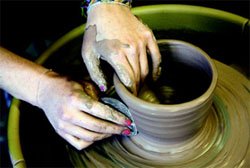Focusing on the Clay in Doug Herren's Potter's Wheel Course
Focusing on the Clay in
Doug Herren's Potter's Wheel Course
by Jeffrey Lott/ The Bulletin
4/17/2009
|
|
|
There's nothing quite so elemental as a lump of wet clay - or so magical as seeing skilled hands turn that spinning lump into a beautiful vessel. Doug Herren, studio technician for the Art Department, is a teacher of this magic, which a dozen students in this spring's class The Potter's Wheel variously describe as "very physical," "a little stressful," and "a pretty steep learning curve." The first assignment, just completed, was to make four six-inch tall cylinders and four cups with handles. Today's task is to make a bowl.
Potters call working on the wheel "throwing," and Herren, who demonstrates technique at the beginning of each class, says, "Learning to throw is hard. You need to build up dexterity and strength. It's all about getting hands-on in the very first class." For nine years, he taught part time at Rowan University and is happy to be full-time at Swarthmore, where he works primarily in the clay studio but also supports other Art Department faculty and students with their projects. He's serving as a visiting assistant professor this year because Professor of Studio Art Syd Carpenter is on leave.
The Potter's Wheel is the first art course for Ben Hopkins '09, a history major and economics minor now in his last semester at Swarthmore. He calls it "a nice way to relieve stress-to blank out and become thoughtless for a couple hours." Then he's off to multivariable calculus or advanced econometrics.
The studio is open 24 hours a day. That suits many students, who like to come in late at night, turn up some music, and throw. "It's relaxing compared to my other classes, but I was a little nervous," says Alexis Hickman '11. "I had never taken a course like this before-even in high school. Everything I throw is a little uneven."
Senior psychobiology major Juliana Macri found the wheel particularly daunting. "The first time was disastrous," she says. But as she learns, she says, her mind "gets really focused on the clay and what it's doing. I'm a perfectionist, so I spend a lot of time trying to make things perfectly smooth and circular. This is something I should probably stop doing-sometimes things that aren't perfect are more interesting."



